Did you get the England and Northwestern Europe DNA ancestral region in your Ancestry DNA results? Was it a surprise to you, or were you expecting it? Learn in-depth details about this DNA ethnicity in this article.
You'll discover:
- Where this DNA ancestral region is located
- In which countries the England and Northwestern Europe DNA ethnicity is located
- How this DNA ancestral region was formed - the genetic makeup of the region
- Ideas as to how you may have inherited this DNA ethnicity
- How to get started researching your family tree - the best way to really understand your DNA origins results
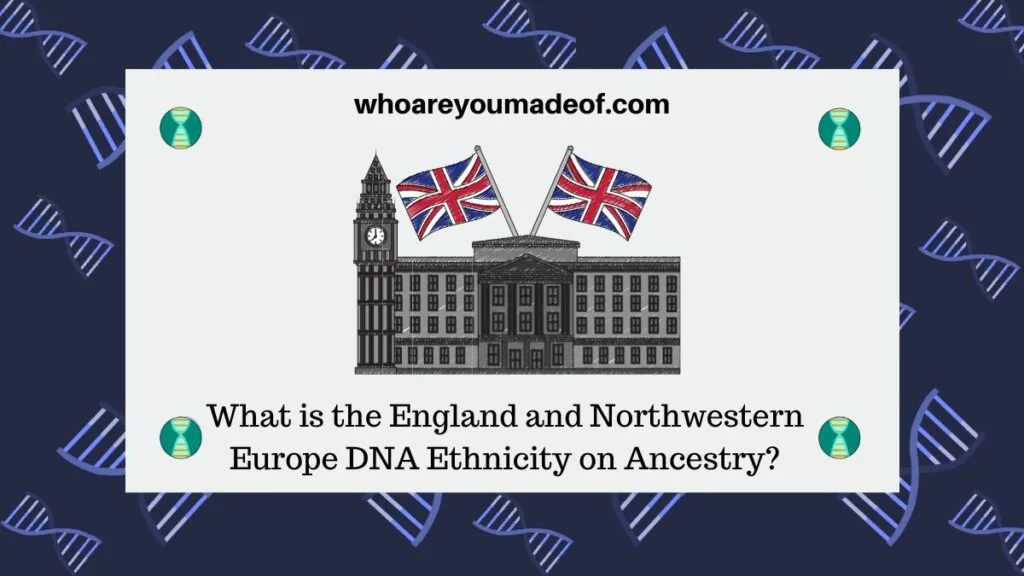
Many people who live in the United States are vaguely aware of at least some English ancestry. Many people have a variety of ancestors from the region that can be found if their family tree and have likely contributed to their genes.
Where is the England and Northwestern Europe DNA Ancestral Region located?
In the image below, you can see where the England and Northwestern Europe DNA ethnicity region is located. The region covers England, as you might expect, as well as the Guernsey and Jersey Islands.
Some people with proud Irish, German, Scottish, Dutch, and even French heritage might be surprised to see that parts of these countries are also covered by this region.
It is important to note that this DNA region has significant overlap with some of the neighboring DNA regions, most notably the Germanic Europe region, as well as the Ireland and Scotland region.
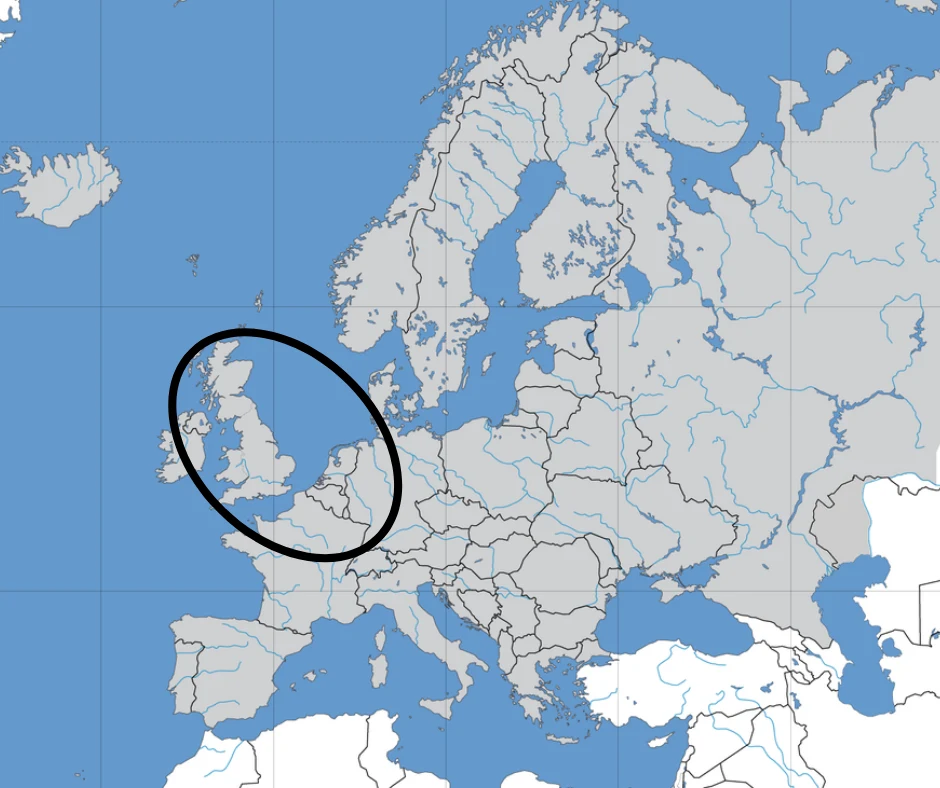
By David Liuzzo [GFDL, CC-BY-SA-3.0 or CC BY-SA 2.0 de], from Wikimedia Commons
In which countries can you find England and Northwestern Europe DNA?
According to Ancestry DNA and the way in which they have defined this particular DNA region, the main focus of the England and Northwestern DNA region is located in the country of England.
The nature of Europe's politics and geography being what they are, and always have been, it's very common to find DNA from this region in neighboring regions.
Aside from the epicenter of this DNA region, which is England, you can find this DNA in the following Northwestern Europe countries, albeit in smaller percentages:
It is important to take into consideration the fact that an ancestor who was not "from" the England and Northwestern Europe DNA region could have had ancestry from there, and this ancestry could have been present in their DNA.
For example, if I only had German ancestors and had some DNA from England and Northwestern Europe, it doesn't mean that my results are wrong.
Instead, it could mean that some of the ancestors of my ancestors, perhaps too far back for me to trace using documents and records, could have lived in that region.
So What is England and Northwestern Europe DNA?
The people who lived in the England and Northwestern Europe DNA region thousands of years ago spoke different languages, had different cultures, and even likely looked very different. All of these different groups of people are part of what we consider to be the genetic makeup of the English people.
There have been dozens of events throughout history that have shaped the genetic makeup of the people of England and Northwestern Europe. There is enough to write an entire book, in fact.
I have selected a few of the most important historical events to give you an idea of how people in this area came to be who they are today.
Who "originally" lived in Britain?
The people who originally lived in the part of Europe covered by this DNA region, including what is now the United Kingdom, Ireland, France, Germany, and even part of the Netherlands, were Celtic.
The Celts weren't a unified group of people. It's the word that we use to describe these groups of tribes whose languages had a common (Celtic) origin and whose cultures were similar.
The most commonly accepted idea is that Celtic tribes arrived in Europe, possibly from the Middle East, and eventually moved west due to pressures from Germanic Tribes. Later, the Roman Empire continued this pressure.
One dramatic piece of evidence that supports this theory is a map showing the places where Celtic languages were once spoken, and where they are still spoken today:
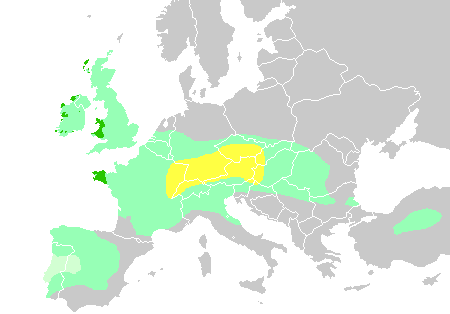
By QuartierLatin1968,The Ogre,Dbachmann; derivative work Rob984. - Derived from File:Celts in Europe.png, omission of the early modern stage. Sources for data: See File talk:Celts in Europe.png, CC BY-SA 4.0, https://commons.wikimedia.org/w/index.php?curid=50243888
Germanic Angles and Saxons in Britain left their DNA
As I mentioned previously, the Celtic inhabitants of the England and Northwestern Europe DNA region were eventually pushed westward by its new inhabitants, Anglo-Saxons. These were people from Germanic tribes that had previously inhabited other parts of Europe, including what is now Germany and Denmark.
You have probably already heard of the Anglo-Saxons, since it is from these people that those of us with ancestry from this region are descended. The Anglo-Saxons thrived in what is now England, eventually adopted Christianity and formed political relationships with continental Europe.
Is British DNA Viking?
The Viking Age gave rise to about two hundred years of fear, and possibly also the phrase "A furore Normannorum libera nos, Domine", which is loosely translated as "Free us from the furor of the Northmen, Lord". Originally a prayer, it appears to have recently become popular in the musical genre of "heavy metal".
It's true that if this phrase were really commonly used in Britain during the Viking Age, it would not have been said in Latin! Most Vikings spoke Old Norse, a classical North Germanic language spoken by people who lived in Scandinavia.
We may never be sure whether the phrase is as old as the Viking Invasions, but what we can be sure of is the fear that these invasions spread throughout Europe. Those parts of Europe that were easily accessible by water along the coast were especially vulnerable to Viking incursions.
The Vikings, or Norsemen, led raids on coastal communities from Ireland to Spain, and even established settlements to assist with the extraction of resources, including slaves, from these areas.
Vikings left DNA in Britain
Even though they have a terrible reputation (and so long after the fact!), the Vikings did leave their mark on Britain and the other areas where their raids were common.
It is likely that many women were raped during raids, as is so common during violent conflict even in modern times, and so Viking DNA was left in this way in all of the regions where Vikings invaded.
Likely more influential on the genetic makeup of the region, some Vikings migrated to the places where they established settlements and brought their families. In fact, there were extensive permanent Viking settlements in the region.
These settlements led to increasing political influence. Eventually, they adopted local customs and became part of the DNA of the region, so-to-speak.
In the 11th century, the Danish King Cnut the Great became king of England, Norway, Denmark. Parts of Sweden were included in his realm, too.
Random, but interesting thought:
One possible reason that the Vikings have such a terrible lasting reputation among people of European descent? The Scandinavians, some of whom were these "Vikings" participating in these raids of terror, were the last people in Europe to adapt Christianity.
This means that not only were these raids violent, but it was violence perpetrated by non-Christians towards Christians, and was perhaps viewed as exceptionally egregious for this reason. Alternatively, this view may have been superimposed at a later point in history.
Is there such thing as Northwestern European traits?
People from Northwestern Europe have a diverse variety of physical traits. There is no single "phenotype", or observable characteristic, that can help you identify whether you have ancestors who lived in this area.
How did I get England and Northwestern Europe in my DNA Results?
Exactly how we inherited our DNA from the England and Northwestern Europe region will depend on our geographic location and our unique family history.
Someone with recent ancestors from the UK won't be surprised to find this region in their DNA results, of course. Others with no known roots in this region might be surprised by it.
The British Empire spread genes all over the world
No discussion of British DNA (or the England and Northwestern Europe DNA ancestral region) would be complete without mentioning how instrumental the geographic span of the British Empire was in helping spread DNA from this area all over the globe.
Most of us are very familiar with the influence of the British Empire (i.e. I'm in a part of North America that is now the United States and I'm writing this article in English).
To get an idea of the incredible geographic reach of the British, and thus, British DNA, check out the map below. If you have ancestors who ever lived any of the regions highlighted as part of the empire, then you might have inherited England and Northwestern Europe DNA from them.
The British Empire ruled over almost 25% of the world's population in a geographic area equal to almost 25% of the world's land mass.
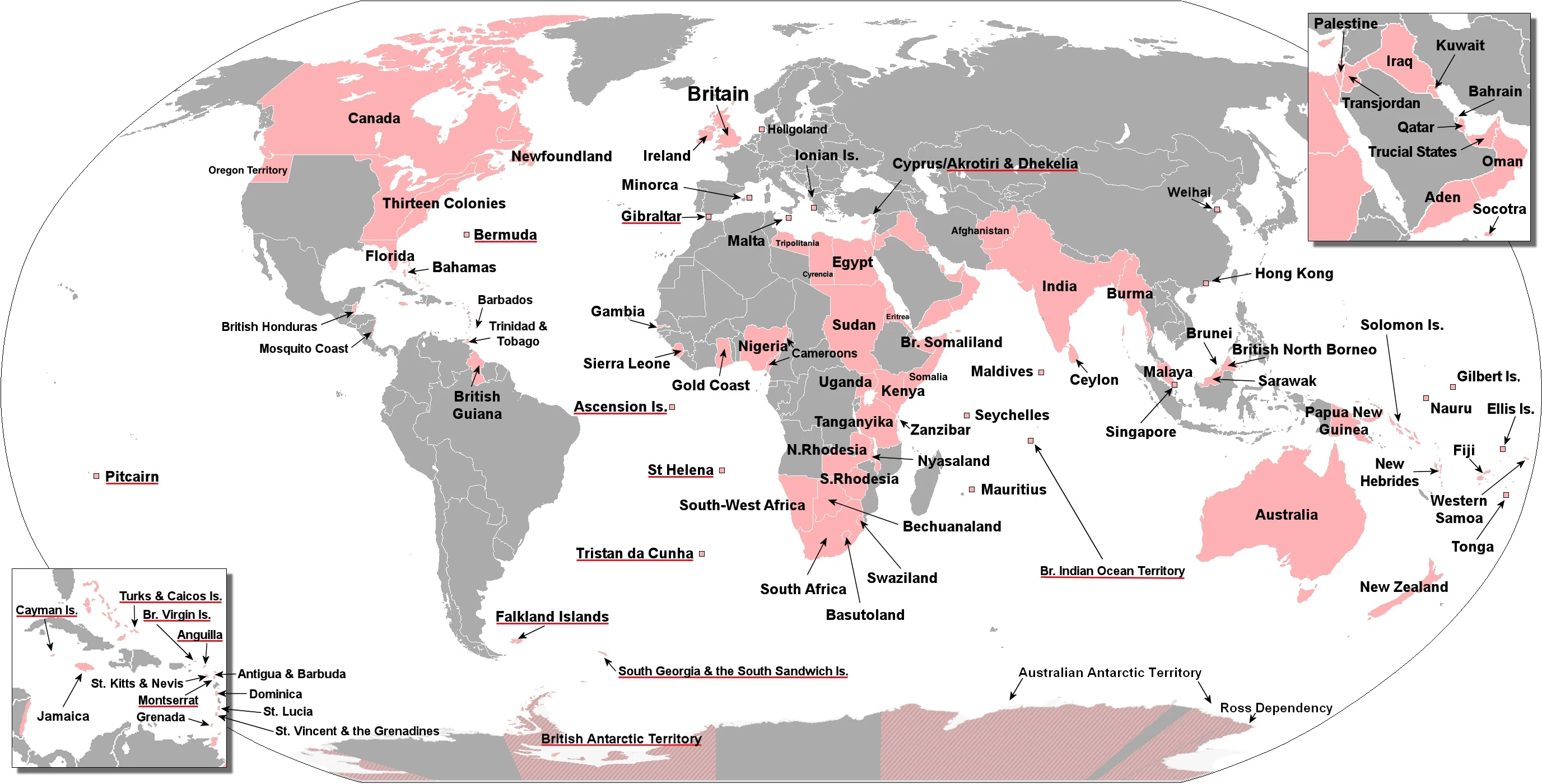
How to Research My England and Northwestern Europe Ancestry?
The best way to find out exactly how you got your England, and Northwestern Europe DNA is by building a family tree. It would be so amazing if our DNA test could just go ahead and tell us this information, but this is still not possible.
The good news is that, once you get familiar with the basics, family tree research is actually really fun. In fact, even if a DNA test could automatically build my tree for me, I think I would still much prefer the excitement of doing it myself.
Most people know, or have access to people who know, much more about their family tree than they think they do. By talking with your older relatives, like parents, aunts, uncles, grandparents, and even older cousins, you will be able to get enough clues to get a good start on your family tree.
Build a basic family tree to trace your England and Northwestern Europe roots
Once you learn about your family history going back a few generations, you'll have a good idea as to which line(s) of your family you need to further research in order to find your ancestor, or ancestors, who were born in the England and Northwestern Europe DNA region.
Now that you have begun to learn about your roots, it's a good idea to plug everything into an online family tree. I always build my trees on Ancestry, especially since I tested my DNA there and like the additional features available (I've linked my tree to my DNA results).
It's free to build a tree, or multiple trees, but you will need a subscription for access to documents, records, photographs, and other people's family trees. The documents and photos that you upload yourself to your tree are always available to you (with or without a subscription).
If you want to give Ancestry a try, you can always start building your tree there. You can always download your tree to move it somewhere else if you would prefer.
When I am busy with research, I generally use the Ancestry subscription.
To learn more about building a simple family tree (I swear it's super fun!!), you can read the following posts, or read my book, Family Tree Building Basics: A Book for Beginners, which you can get immediately as a PDF download or in softcover on Amazon.
- How to build a family tree on Ancestry (this is my highly recommend place to build a tree)
- How to use DNA matches to build family tree
Check out your Ethnicity Inheritance by parent results
Your Ancestry DNA results can help you figure out which side of your family tree DNA from the England and Northwestern Europe region came from. This can be seen by scrolling down on your DNA Story page (i.e. the "DNA Origins") to the View Regions By Parent section.
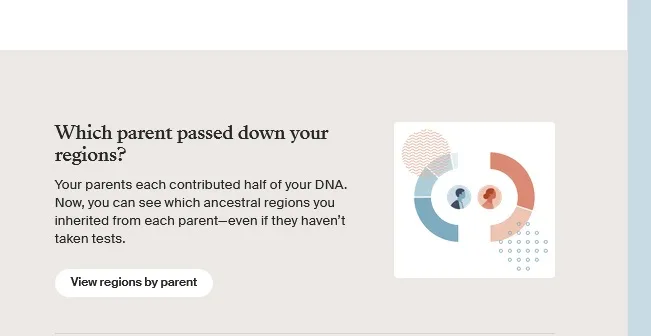
Click where it says "View breakdown" to see which regions came from each of your parents in the Ethnicity Inheritance by parent results. You will be able to see this information even if your parents have not taken DNA tests.
Explore your England and Northwestern Europe Sub-Regions and Ancestral Journeys
Some people who show the England and Northwestern Europe Sub-Region in their DNA results might also have a sub-region show up. If this happens for you, consider yourself fortunate.
According to Ancestry, sub-regions are very accurate. Their technology can detect ancestry in the sub-regions going back as far as 1000 years, which means that some of us who got a sub-region might not even have discovered ancestors for that region yet.
There are currently four sub-regions that can show up for the general England and Northwestern Europe ancestral region:
- Channel Islands
- East Midlands, Yorkshire & the Humber & North East England
- South East & East of England
- West Midlands & North West England

As of January, 2025, there are at least 164 Ancestral Journeys and sub journeys related to the England and Northwestern Europe Ancestral Region.
Currently, the general regions of DNA Communities include:
- Birmingham (6 sub Journeys)
- Central Southern England (20 Sub Journeys)
- Devon, Dorset & Somerset (9 Sub Journeys)
- East Midlands, Yorkshire & North England (20 Sub Journeys)
- East of England (16 Sub Journeys)
- Eastern South East England (13 Sub Journeys)
- Great London to Southern East Midlands (9 Sub Journeys)
- Isle of Man
- Leinster (21 Sub Journeys)
- Northern England & Scotland Border (8 Sub Journeys)
- North West England and Northern Wales (23 Sub Journeys)
- The Midlands (18 Sub Journeys)
If you received any of these sub-regions or ancestral journeys on your results or a more specific sub-region, you can be sure that you have ancestors who called that place home in the past. You may have very recent ancestors who came from that area.
People can also receive very specific ancestral journeys from the England and Northwestern Europe regions if a large portion of your ancestors lived in that area for generations in your family tree. I have seen instances of people belonging to ancestral journeys, such as the Isle of Man, from ancestors who lived in the region 100-200 years ago.
Some people have recent English ancestors and do not show any specific ancestral journeys in England on their results. My grandmother, for example, had a great-grandfather from Devon, England, yet shows no match to this area on her DNA results.
What happened to the England, Wales, and Northwestern Europe DNA Ethnicity region?
For a few years, Wales was included along with the England and Northwestern Europe region. Ancestry has science developed the technology to be able to better isolate Wales ancestry.
Now, people with ancestors from the country of Wales, located on the island of Great Britain, may find the Wales DNA Ethnicity Region and four possible DNA Communities in Wales. This is especially true for those with more recent Welsh ancestry.
If you did your Ancestry before September 2020, you may have noticed that your ethnicity estimate has changed, perhaps more than once. If you want to know more about the changes, you can read about why your Ancestry DNA results change.
The England and Northwestern Europe DNA ethnicity was previously known as the Great Britain region, since the geographic scope of the DNA region has shifted.
Conclusion
I hope that this post gave you some insight into how you inherited your England and Northwestern Europe DNA, and some background on the region.
If you have any questions about something that you read in this post, or would like to share how much DNA from this region you got in your results (and whether or not you got a sub-region!), it would be great to hear from you in the discussion below.
Thanks for stopping by!


Mary
Sunday 4th of June 2023
Hello. Since you are aware of English culture and language you must be aware of your mistake in this sentence - “Vikings” participating in these raids of terror, were the last people in Europe to adapt Christianity.
Rachel
Sunday 27th of November 2022
I find it so amusing that people are so interested in their origins.
I respect their right to be interested but for me personally I am not interested whatsoever.
I came across this site by chance and found it fascinating to read of so many people involving themselves to find their origins. What difference does it make what tribe a person comes from in the long-term. If you are healthy and acceptably happy, be content with that. I know I am. Life is too short to get entangled with origins that can't be truly known for sure anyway. Rachel.
Sheila Seiferlein
Monday 18th of March 2024
@Rachel, Some people are curious and others are not. What may be unimportant to you may be important to others. It's simply part of being human!
Larry Tate
Thursday 23rd of February 2023
@Larry Tate, Kerrin Hoppage Turner.
Larry Tate
Thursday 23rd of February 2023
@Rachel, for most people it’s a hobby. I have learned many interesting things through DNA and discovering family I did not know I have. I have relatives in Virginia and Alabama that I now keep in contact with. I have a Great great grandmother who was a spy in the Revolutionary War and invented a medical device that helped soldiers who were wounded and died at the age of 92 riding horse back while hunting. There is a monument dedicated to her in North Carolina, her name is Keri’s Hoppage Turner. This is why people look to DNA and ancestry, because someone sacrificed something to see that future generations would have something to hold on to as they had. I hope this helps you to understand.
Mercedes
Wednesday 30th of November 2022
Hi Rachel, I agree that the most important thing is being happy, healthy, and safe! Thank you for taking the time to leave a comment! Sincerely, Mercedes
Tonia Michelle Feagle
Monday 14th of November 2022
What is Viking background? My family came to Jamestown in 1607 and were black Irish. I assumed this is concerning half breed children from Spaniards coming to port but it could also be Vikings. My family tree is according to the book my aunt put together years ago going back before 1607. It shows every generation and the references but our name doesn't show up in an article about the first settlers. Although they came with the second settlement, first supply ship. The thing is that if the list in the article is the first settlement, (being why our name isn't listed) didn't the second ones come and not find anyone left from the first ones? Also this article is in 1607, the same year the second settlement got there. Learning about the Vikings, the Celtics and being an a descendent of the Israelite. Thank you for all this great info. One other idea I had that I heard schizophrenia is prevalent in Irish background and this has made me think that the great potato famine and the creation of alcohol out of anything they could find causing blindness and death also altered their dna that they passed down to their children. Since schizophrenia seems so alcohol related also. What brought me to this article is my daughter got a DNA test and it said 72% England & northwestern Europe, 11% whales, 9% Scotland, 4% Sweden & Denmark and 4% Norway. So it has me down as 34%, 8%, 3%, 1%, 4% on same places. But that equals only 50% of mine. I don't understand that part. Oh thats how much of it came from me? So there could be parts I didn't pass to her? Interesting.
RR
Tuesday 4th of October 2022
you really should have added a trigger warning for talking about such heavy topics in the viking section....
bridgette kellhofer
Tuesday 22nd of February 2022
I am England,Wales & Northwestern Europe 46%, Ireland & Scotland 44%, Germanic Europe 4%, Eastern Europe & Russia 4%, Sweden 1%, Southern Asia 1%, and Western & Central India.<1%, What does this all mean? where do I even start?
Sheila Seiferlein
Monday 18th of March 2024
@bridgette kellhofer, If you tested with Ancestry, Family Tree DNA or 23 and Me, you're in luck. I can highly recommend GED Match since you can upload DNA from those three companies. There are some free cool tools you can use--one is the archaic DNA calculator which will, I'm sure will prove interesting, as is the Admixture (heritage)--the last is how I know I carry some very interesting heritage, including Australasian, Oceanian Siberian, Ukrainian, Iberian, Russian and way, back, San. Yet my 23 and me shows only Northern Irish, East Lancashire/West Yorkshire, German, and French, Finnish, and Amerind. However their DNA search doesn't go far, far back. You need companies like Gedmatch, My True DNA, and Genome link to get a more complete picture. Caution: the last two require you to pay for reports to get a deeper dive. I hope this will help.